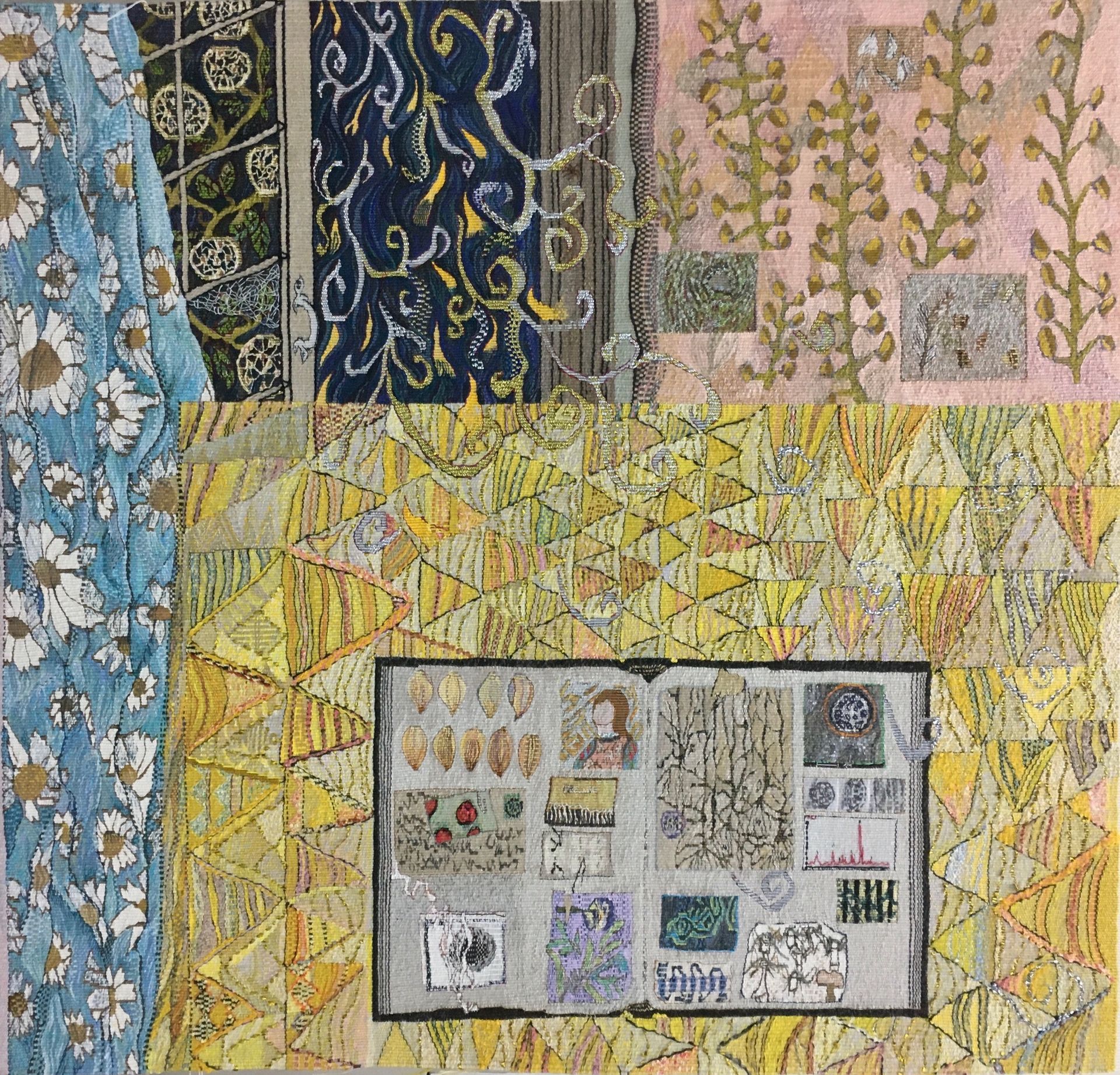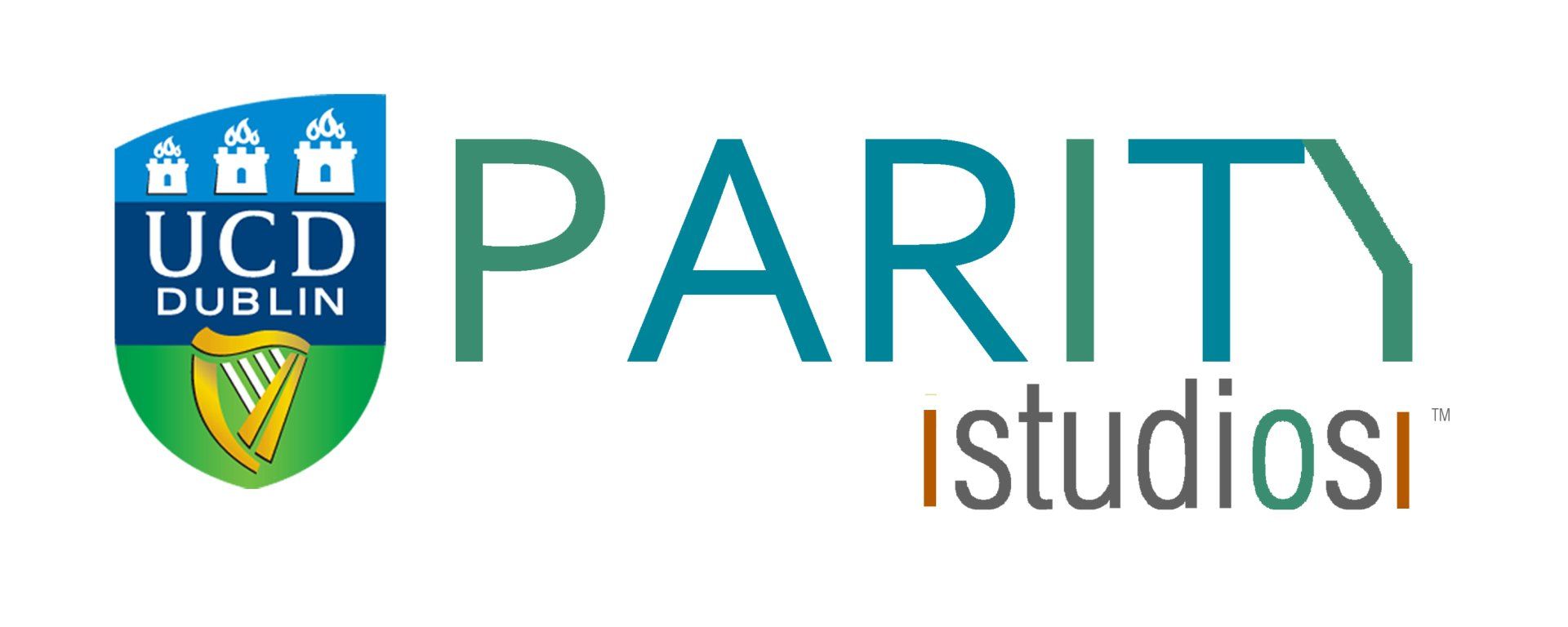Lorna Donlon
Artist In Residence UCD College of Science
Science is very near us -
visualising evening odorants of gorse, at the table by the window
Hand woven tapestry, cotton, wool, silk, linen, rayon, metallics, old fabrics, 120cm X 120cm , 2022
Science is very near us -
visualising evening odorants of gorse, at the table by the window
The title of this tapestry references something the poet Emily Dickinson once wrote in a letter to a friend; “...science is very near us, I saw a Megatherium on my strawberries...” A Megatherium is, in fact, a species of giant sloth that went extinct shortly after the last Ice Age, some ten thousand years ago, so although we are none the wiser as to what she had seen on her strawberries, I believe she was completely right – science really is very near us.
This tapestry combines various biographical ‘moments’ into one imagined scene, in which the ‘invisible’ scent of gorse, silver and gold, heavy in the early summer evening air, floats through an open window onto an old, long remembered heavy textured, ‘gorse yellow’ tablecloth. Lying open on the tablecloth is a sketchbook of collected images and ideas, some scientific, some personal, about the sense of smell and how it works. Included among these are some current research images generated by scientists working in UCD at the moment. 5th century Coptic weavers from Egypt or Medieval weavers from 1400s Europe tended to weave what they saw around them in their daily lives, which now gives their tapestries an extra layer of historical meaning. In following that tradition, the unusual and unique rendering of 2020’s UCD research images into a woven tapestry creates an extra layer of significance and interest.
Sincere thanks to the following UCD Scientists for permission to depict their current research in my woven tapestry, to; Dr Jean-Christophe Jacquier and Michelle Kearns BSc for running my (nocturnally!) collected gorse flowers in their amazing GCMS machine at very short notice to generate the unique Ulex europeaus (Gorse) volatile chromatogram; Professor Oliver Blacque and Sofia Tsiropoulou PhD for their Transmission Electron Microscope images of the C.elegans ciliary axoneme, one of the most beautiful and most useful and important biological structures, upon which their research is based; and Professor Gareth Redmond, David Ferris BSc and Chenxi Hao BSc for the fluorescent image of their high tech high spec Polyphenylenevinylene (PPV) microsphere ‘robots’ and Karl Griffin BSc for his image of Squaraine (SQ) nanowires on electrodes, otherwise known as a ‘synthetic neuron.’
Life in the gorse -
concerning the Throstle and the Fairies’ Mavis
2022
55cm X 55cm
framed handwoven tapestry
cotton, linen, silk, old fabrics, metallics
Most of the time while I was weaving my large tapestry ‘Science is very near us – visualising evening odorants of gorse, at the table by the window,’ as well as considering my wish to capture a moment frozen in time, both personal and one that communicates current scientific endeavour, I was holding in my head the idea of an equivalence. I repeatedly wondered if, in ways, perhaps there is not much difference between the essentials of my activity as an artist / tapestry weaver to those of a song thrush, on the scale of things. Hence, the reimagined ‘gorse yellow’ table cloth that holds the sketchbook of my tapestry is equivalent to the yellow gorse bush that supports the song thrush, in this smaller tapestry. And the open page of my sketchbook scattered with collected images, memories, discoveries and ideas, reflecting an activity entirely necessary to me as an artist, has an equivalence in the song thrush’s favoured anvil stone, hidden under the gorse, strewn as it is with bright shiny fragments of shell patterns, evidence of nourishment and sustenance, albeit of a different, more fundamental physically essential kind.
The Throstle and the Fairies’ Mavis are both names given to the Song Thrush.


‘Things I found in other worlds’
A series of displays combining arrangements of found, borrowed and assembled objects.
Six free standing glass cabinets
150cm x 50cm x 40cm each
These cabinets, each with a specific theme as detailed below, act as ‘thoughts and ideas’ about some of the things that have stayed with me from all the information I received both during and since my Cell and Molecular degree in UCD.
Electron
that this is how it is
- to do with charge
small bits of nothings with
positive charge negative charge
whatever that is,
there at the bottom of all things
is
something of a shock to me
A bird listens for electrons, long gone electrons,
coins and washers alternate into a battery, now dead, that lit an LED for at least 300 minutes.
a set of wires from the Chemistry Store refuse to stand, and so they lean.
out of a petri dish, electric wires grow, an odd experiment,
a necklace, there for the Greek; ‘Amber’ for electron.

Communication - over and out
a single cell won’t stay alive all on its own for very long
it needs to know that it is not alone, that it is needed by some other cells
when you keep one on its own, if you can get one on its own,
it doesn’t last, it packages itself up and surrenders its contents
and dies.
this is the truth.
we heard that Martin Raff offered £10,000 to the first person who found these survival signals that cells send to each other because we still don’t know what they actually are. I think I know what they are and when I go into the lab I know I will find them because I want the money and also, I want to be right. But that’s not science. As Paul McCabe says...that’s religion.
two sets of cells communicate, signals are sent and received, receptors decorate membranes, long flagellar cilia extend, probe, sweep the space, releasing signals, searching for signals.
In an example of biology meeting physics which is where interesting gets real The Little Gull meets The Plank’s Constant Apparatus. They are very different. But also, they are the same.

The Knot
it is a textile landscape,
strands, loops, coils,
fringes,
nets,
pores threaded, fragments stitched,
and in the thread of life, not a knot in sight.
The Knot, a small seabird, wears a knot, now that his tide living days are done.
The looping knot of a misfolded protein, is fed through the Proteosome, a macromolecular recycling machine.
A polypeptide string is threaded through a channel in the ER membrane for folding, like my granny threaded a needle, by looping the end of the thread not trying to stick it straight in.
A piece of string from an apron, knotted and held in a pocket, for the feel of the knots.
A knot of fabrics I wore for all the years I had a knot in my stomach.
16 knots in 8 white threads, precisely measured and knotted, that will hold the doors of Eirsat1, Ireland’s first satellite, closed when it is launched into space, until they melt them by remote control and the 8 threads break and the doors open and the Satellite antennae unfold.
Beads on a string, the characteristic way we see DNA in electron microscope images.
The thread of life, white strands of salmon sperm DNA, like cotton fibre, in a petri dish.
Leaves of the marine lace plant, that Jo is growing in the lab, to study programmed cell death in plants, because this plant, at a certain point in its development makes lace of its leaves, by killing its cells in a controlled, programmed way.

